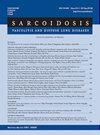远程康复治疗结节病的效果
IF 1.8
4区 医学
Q4 RESPIRATORY SYSTEM
Sarcoidosis, Vasculitis, and Diffuse Lung Diseases
Pub Date : 2022-03-31
DOI:10.36141/svdld.v39i1.12526
引用次数: 4
摘要
背景:结节病可导致不同时期的疾病和失业。结节病建议康复以提高运动能力。因此,专注于创造适应工作患者需求的不同和灵活的康复选择是有必要的,以保持结节病患者的就业并减轻社会经济负担。远程康复(TR)可能是另一种选择。我们调查了TR对结节病患者运动能力的有用性和有效性。方法:单中心、前瞻性、随机研究包括稳定的结节病的人参加一个对照组,他们收到了普通标准护理(不包括康复)或3个月TR组组成的视频和chat-consultations理疗医师和锻炼会话与物理虚拟自治代理(VAPA)(1)。6-minute-walk-test (6 mwt)、用力肺活量(FVC)、扩散能力的肺一氧化碳(DLCO),在TR治疗3个月前后以及随访3个月和6个月后,分别检测等长自愿收缩(MVC)、7天步测法、圣乔治间质性肺病呼吸问卷(SGRQ-I)、国王简短间质性肺病问卷(KBILD)和一般焦虑障碍-7问卷(GAD7)。患者满意度以5分制测量(5分非常满意),并以任务和培训时间的百分比计算依从性。记录了不良事件。结果:30例患者,年龄53.9±13.5岁,男性63.3%,FVC% 88.9±18.8,DLCO% 65.2±16.0,mwt 613.1±141.3。15例患者随机分为合并VAPA的TR组和对照组。行走距离(6MWTD)在基线(-28.9 m (p=0.58))、3个月(+25.8 m (p=0.57))、6个月(+48.4 m (p=0.39))和9个月(+77.3 m (p=0.18))时的差异有利于远程康复。MVC、7天计步法、sgrq - 1、KBILD或GAD7均无差异。干预组的运动依从性为64%,前3个月平均每次运动时间为28分钟。患者满意度得分为3.8±0.7。无不良事件报告。结论:在这项结节病患者的初步研究中,VAPA TR没有导致运动能力或患者报告的结果发生任何变化。然而,在随访期间,观察到6MWTD改善的统计学无显著趋势。VAPA TR是安全的,患者满意度高,依从性可接受。需要进一步的随机研究,包括更多的参与者。本文章由计算机程序翻译,如有差异,请以英文原文为准。
Effect of a Telerehabilitation program in sarcoidosis
Background: Sarcoidosis can lead to variable periods of sickness and unemployment. Rehabilitation is recommended in sarcoidosis to improve exercise capacity. Therefore, focus on creating different and flexible rehabilitation options adapted to the needs of working patients is warranted to keep patients with sarcoidosis employed and to reduce the socioeconomic burden. Telerehabilitation (TR) might be an alternative. We investigated the usefulness and effectiveness of TR on exercise capacity in patients with sarcoidosis. Method: Single-center, prospective, randomized study including stable patients with sarcoidosis who were enrolled in either a control group where they received the usual standard of care (not including rehabilitation) or in the 3 months TR group composed of video and chat-consultations with a physiotherapist and workout sessions with a virtual autonomous physiotherapist agent (VAPA) (1). 6-minute-walk-test (6MWT), forced vital capacity (FVC), diffusion capacity of the lung for carbon monoxide (DLCO), isometric voluntary contraction (MVC), 7 days pedometry, Saint George Respiratory Questionnaire for interstitial lung disease (SGRQ-I), The King’s Brief Interstitial Lung Disease Questionnaire (KBILD) and General Anxiety Disorder-7 Questionnaire (GAD7) were tested before and after 3 months of TR, and after 3- and 6 months follow-up. Patient satisfaction was measured with a 5-point scale (5 very satisfied) and adherence was calculated as percent of tasks and time spent training. Adverse events were documented. Results: Thirty patients aged 53.9±13.5 years, male 63.3%, FVC% 88.9±18.8, DLCO% 65.2±16.0, 6MWT 513.1±141.3 were included. Fifteen patients were randomized to TR with VAPA and 15 patients to the control group. Differences in meters walked (6MWTD) between groups was at baseline (-28.9 m (p=0.58)), after 3 (+25.8 m (p=0.57)), 6 (+48.4 m (p=0.39)) and 9 months (+77.3 m (p=0.18)) follow-up in favor of telerehabilitation. No differences were observed in MVC, 7 days pedometry, SGRQ-I, KBILD or GAD7. Exercise adherence in the intervention group was 64% and average exercise time was 28 minutes per exercise session during the first 3 months. Patient satisfaction scored 3.8 ± 0.7. No adverse events were reported. Conclusion: VAPA TR did not result in any change in exercise capacity or patient-reported outcomes in this pilot study in patients with sarcoidosis. However, a statistically non-significant trend for improved 6MWTD was observed during follow-up. VAPA TR was safe, had high patient satisfaction and acceptable adherence. Further randomized studies including larger numbers of participants are needed.
求助全文
通过发布文献求助,成功后即可免费获取论文全文。
去求助
来源期刊
CiteScore
2.20
自引率
6.20%
发文量
34
期刊介绍:
Sarcoidosis Vasculitis and Diffuse Lung Disease is a quarterly journal founded in 1984 by G. Rizzato. Now directed by R. Baughman (Cincinnati), P. Rottoli (Siena) and S. Tomassetti (Forlì), is the oldest and most prestigious Italian journal in such field.

 求助内容:
求助内容: 应助结果提醒方式:
应助结果提醒方式:


